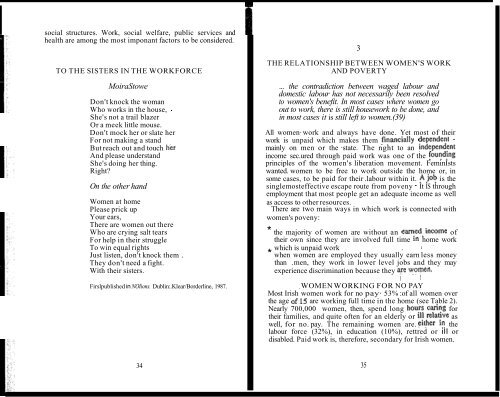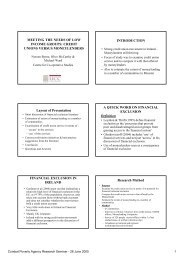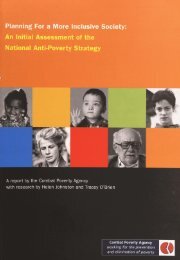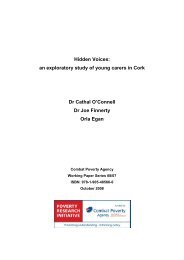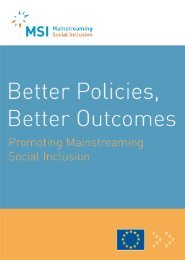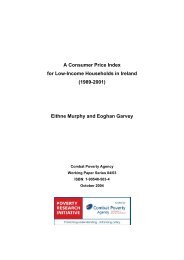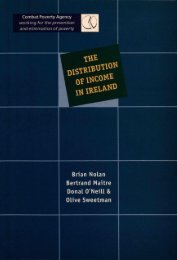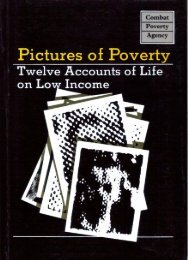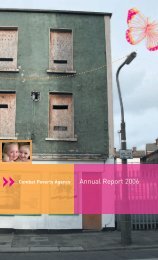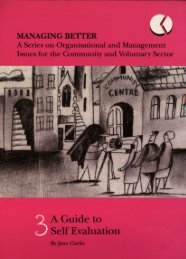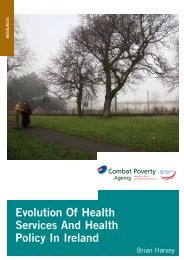Women and Poverty (1989) - Combat Poverty Agency
Women and Poverty (1989) - Combat Poverty Agency
Women and Poverty (1989) - Combat Poverty Agency
Create successful ePaper yourself
Turn your PDF publications into a flip-book with our unique Google optimized e-Paper software.
wife) can be difficult to satisfy. Peter Ward's research found a<br />
57% success rate among a sample of 266 applications for<br />
:deserted wife.'s' payments over the last seventeen years, for<br />
mstan~e. WhIle valued for its security, welfare can be<br />
degradmg .for. women reari~g children on their own. Applying<br />
the cohabllanon rule for mstance - where welfare officials<br />
seek. to ~stabl~sh whether a woman claimant is· having a<br />
relanonshIP. wIth a man - can be deeply invasive of a<br />
woman's pnvacy. ' . . .<br />
The number of one-parent families is growing in Irel<strong>and</strong>, as<br />
elsewhere. By 1986 the number of one-parent families had<br />
grown to ~ver 97,000, maki~g up 10% of all private<br />
house~olds .m. Irel<strong>and</strong>. Trends m Irel<strong>and</strong> may soon mirror<br />
those m Bntam where one-parent families were the fastest<br />
grO\y~ng group in poverty during the 1970s.(15) One-parent<br />
farmhes ~ow ~~e up nearly half of all the families living in<br />
poverty m Bntam. Such trends are seemingly universal:<br />
between one-quarter <strong>and</strong> one-third of all families worldwide<br />
are supported by women <strong>and</strong> these families have been found<br />
to be le.ading c<strong>and</strong>idates for poverty <strong>and</strong> hardship.(16) One of<br />
~e ~m ~easons why one-par~nt families have both a high<br />
nsk 01 bemg poor <strong>and</strong> of staYIng poor is because they are<br />
~enied access to the most effective route out of poverty: fullnme<br />
employment for both parents.(17)<br />
Elderly <strong>Women</strong><br />
In Irel<strong>and</strong> in 1986, there were 384,355 people aged 65 years<br />
<strong>and</strong> over, representing 11% ofthe population. The numbers of<br />
elderly are growing all the time so that there is a general<br />
ageing of the population - as people are livinglonger we have<br />
more old <strong>and</strong> very old people. <strong>Women</strong> dominate the over 65s<br />
in greater numbers as one moves up the age range: 56% of all<br />
those over the age of 65 are women, but women are twothirds<br />
of all those who reach, 80 years of age. Although the<br />
ESRI research suggested·that poverty among the elderly had<br />
declined !Jetween 1980 <strong>and</strong> 1987, the general consensus of<br />
research IS that more women than men end their lives in<br />
poverty. . . ,<br />
There.are a number of reasons for this. First, women live<br />
longer; since l?ld age is closely associated with poverty,<br />
women predonunate among the aging poor. Secondly, women<br />
are poorer before they reach old age - throughout their lives<br />
they have had less access than men to all kinds ~f resourc.es<br />
but especially employment (<strong>and</strong> therefore occupanonal SOCIal<br />
welfare benefits, including a contributory pension). <strong>Women</strong>,<br />
then, are less likely than men tp have savings <strong>and</strong> assets with<br />
which they can supplement their income when they are older.<br />
Thirdly, elderly women are more vulnerable to poverty,<br />
isolation <strong>and</strong> loneliness because the majority of them. are<br />
either widowed or single, whereas the majo~ty of ~lderly men<br />
are married. Finally, <strong>and</strong> related to the prevIous pomt, women<br />
are more likely to live alone - for every one m~. over 65<br />
years of age living alone there are two women. LIvmg alone<br />
is closely linked to poverty among the elderly - a recent study<br />
found that 73% of the elderly living alone fell below a<br />
minimum income st<strong>and</strong>ard.(18)<br />
The situation here is similar to that elsewhere. In Britain, for<br />
instance, a hierarchy of financial security exists among the<br />
elderly. Couples are the most secure, then men on their own<br />
<strong>and</strong> finally lone women.(19)<br />
<strong>Women</strong> in ·'Minorities'<br />
Two groups of women have an especially high risk ofpoverty<br />
in Irel<strong>and</strong>: women from the traveller community <strong>and</strong> women<br />
who are homeless. Many in these groups a:e excluded fro!Jl<br />
conventional poverty research: they are unlikely to appear m<br />
the recent ESRI research, for instance, because it is'based on<br />
a sample of the Register of Electors <strong>and</strong> they are rarely<br />
registered." .' . " -. '<br />
Traveller women are at a very high risk ofpoverty, not only<br />
because they are members of a community that is itself very<br />
vulnerable to poverty but also because of their lower status<br />
within that community, At the -time of the! last qensusof<br />
travellers in 1986, 7,863 women travellers were enumerated<br />
(there were 7,883 men).(20) Life is very harsh fOf,traveller<br />
women: on average the Census ~howed that; wo~ent~nd to<br />
marry very young, raise ten chIldren, have a hIgh nsk of<br />
losing some of their children at birth or in ~arly ?hil~ood,<br />
<strong>and</strong> will themselves die at a younger age than women m the<br />
settled community. Life is lived in,very poor conditions <br />
nearly half of all traveller families still live in cjaravans, a<br />
quarter on the side of the road. Think what: this means for, a<br />
18<br />
19


